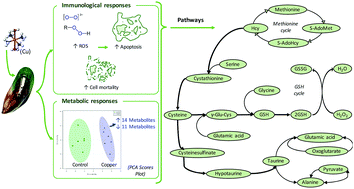当前位置:
X-MOL 学术
›
Metallomics
›
论文详情
Our official English website, www.x-mol.net, welcomes your
feedback! (Note: you will need to create a separate account there.)
Copper-induced immunomodulation in mussel (Perna canaliculus) haemocytes
Metallomics ( IF 2.9 ) Pub Date : 2018-06-11 00:00:00 , DOI: 10.1039/c8mt00092a Thao V. Nguyen 1, 2, 3, 4, 5 , Andrea C. Alfaro 1, 2, 3, 4, 5 , Fabrice Merien 2, 3, 4, 5, 6 , Ronald Lulijwa 1, 2, 3, 4, 5 , Tim Young 1, 2, 3, 4, 5
Metallomics ( IF 2.9 ) Pub Date : 2018-06-11 00:00:00 , DOI: 10.1039/c8mt00092a Thao V. Nguyen 1, 2, 3, 4, 5 , Andrea C. Alfaro 1, 2, 3, 4, 5 , Fabrice Merien 2, 3, 4, 5, 6 , Ronald Lulijwa 1, 2, 3, 4, 5 , Tim Young 1, 2, 3, 4, 5
Affiliation

|
Copper is a common contaminant in aquatic environments, which may cause physiological dysfunction in marine organisms. However, the toxicity mechanisms of copper in marine bivalves is not fully understood. In this study, we applied an integrated approach that combines flow cytometry and Gas Chromatography–Mass Spectrometry (GC–MS)-based metabolomics to characterize cellular and molecular mechanisms of copper immunotoxicity in New Zealand Greenshell™ mussel (Perna canaliculus) haemolymph. Flow cytometric results showed significant increases in haemocyte mortality, production of reactive oxygen species and apoptosis (via alteration of caspase 3/7 and mitochondrial membrane potential) of haemocytes exposed to increasing total concentrations of Cu2+ (62.5, 125.0 and 187.5 μM) compared to a low Cu2+ concentration (25.0 μM) and control (0.0 μM). In addition to flow cytometric data, our metabolomics results showed alterations of 25 metabolites within the metabolite profile of Cu2+-exposed haemolymph (125 μM) compared to those of control samples. Changes in levels of these metabolites may be considered important signatures of oxidative stress (e.g., glutathione) and apoptosis processes (e.g., alanine, glutamic acid). This study provides insights into the cellular and molecular mechanisms of oxidative stress and apoptosis in marine bivalves and highlights the applicability and reliability of metabolomic techniques for immunotoxicological studies in marine organisms.
中文翻译:

铜诱导的贻贝(Perna canaliculus)血 细胞的免疫调节
铜是水生环境中的常见污染物,可能引起海洋生物的生理功能障碍。但是,尚不完全了解海洋双壳类动物体内铜的毒性机理。在这项研究中,我们采用了结合流式细胞仪和基于气相色谱-质谱(GC-MS)的代谢组学的集成方法,来表征新西兰Greenshell™贻贝(Perna canaliculus)血淋巴中铜免疫毒性的细胞和分子机制。流式细胞仪检测结果表明,暴露于总浓度不断增加的Cu 2+的血细胞的血细胞死亡率,活性氧种类的产生和细胞凋亡(通过改变半胱天冬酶3/7和线粒体膜电位的改变)显着增加。(62.5、125.0和187.5μM),而低Cu 2+浓度(25.0μM)和对照(0.0μM)。除了流式细胞仪数据,我们的代谢组学结果显示,与对照样品相比,暴露于Cu 2+的血淋巴(125μM)的代谢物谱内有25种代谢物发生了变化。这些代谢物水平的变化可被认为是氧化应激(例如谷胱甘肽)和细胞凋亡过程(例如丙氨酸,谷氨酸)的重要标志。这项研究提供了对海洋双壳类动物的氧化应激和细胞凋亡的细胞和分子机制的见解,并强调了代谢组学技术在海洋生物免疫毒理学研究中的适用性和可靠性。
更新日期:2018-06-11
中文翻译:

铜诱导的贻贝(Perna canaliculus)血 细胞的免疫调节
铜是水生环境中的常见污染物,可能引起海洋生物的生理功能障碍。但是,尚不完全了解海洋双壳类动物体内铜的毒性机理。在这项研究中,我们采用了结合流式细胞仪和基于气相色谱-质谱(GC-MS)的代谢组学的集成方法,来表征新西兰Greenshell™贻贝(Perna canaliculus)血淋巴中铜免疫毒性的细胞和分子机制。流式细胞仪检测结果表明,暴露于总浓度不断增加的Cu 2+的血细胞的血细胞死亡率,活性氧种类的产生和细胞凋亡(通过改变半胱天冬酶3/7和线粒体膜电位的改变)显着增加。(62.5、125.0和187.5μM),而低Cu 2+浓度(25.0μM)和对照(0.0μM)。除了流式细胞仪数据,我们的代谢组学结果显示,与对照样品相比,暴露于Cu 2+的血淋巴(125μM)的代谢物谱内有25种代谢物发生了变化。这些代谢物水平的变化可被认为是氧化应激(例如谷胱甘肽)和细胞凋亡过程(例如丙氨酸,谷氨酸)的重要标志。这项研究提供了对海洋双壳类动物的氧化应激和细胞凋亡的细胞和分子机制的见解,并强调了代谢组学技术在海洋生物免疫毒理学研究中的适用性和可靠性。











































 京公网安备 11010802027423号
京公网安备 11010802027423号